Table of Contents[Hide][Show]

A staple component of most fruit trays, the widely popular, mildly-sweet, orange-fleshed cantaloupe is well-loved by kids and adults alike. However, there is a bit of confusion surrounding the terminology related to the name of this melon. Let’s see if we can’t use our “melons” and clarify all there is to know regarding this beloved fruit.
Cantaloupe is technically a berry and is related to squash and cucumbers!
In general, melons are the sweet, juicy fruits produced by members of the plant family Cucurbitaceae, which are related to squash and cucumbers (botanically, they’re also technically berries!). Melons originated in Africa and Southwest Asia, were grown by ancient Egyptians, and were brought to Europe as early as 1350 BC (melon seeds have been found in sacred wells in some areas of Sardinia). These fruits were among the earliest domesticated plants in the Old World, and were also one of the first crops to be brought to the New World by westerners. A huge number of melon varieties exist and almost 30 million tons of melons are produced worldwide each year!
Cantaloupe were among the earliest domesticated plants in the Old World, and were also one of the first crops to be brought to the New World.
When looking at cantaloupe specifically, technically a “real” cantaloupe is actually what is known as a ‘European cantaloupe’ which is very different from what North Americans associate the name with. Both are musk melons but the European variety (Cucumis melo cantalupensis) from which the name ‘cantaloupe’ derives, has a rough, warty, unnetted, lightly ribbed, pale gray-green hard rind, while the North American variety (Cucumis melo reticulatus) has a reticulated (net-like or spiderweb-like) peel.
This melon was originally named for Cantalupo, a former papal villa near Rome.
Although cantaloupe originally only referred to the non-netted melons of Europe, today it represents any orange-fleshed melon belonging to Cucumis melo. Just to make things more complicated, this fruit is also referred to as rockmelon in Australia and New Zealand, or by the generic term muskmelon. Confused? Don’t worry – no matter what you call it, it’s tasty and nutritious which is all that matters! However, in case you were wondering, the fruit was originally named for Cantalupo, a former papal villa near Rome, after it was introduced there from Armenia. Around 1890, it became a commercial crop in the United States, where today 75% of cantaloupes are grown in California (European varieties are not widely grown or commercially available in the US and Canada). Like it’s cousin the pumpkin, the seeds of cantaloupe are edible and may be dried to eat as a snack, though not nearly as popular.
Nutrivore Score for Cantaloupe – 457
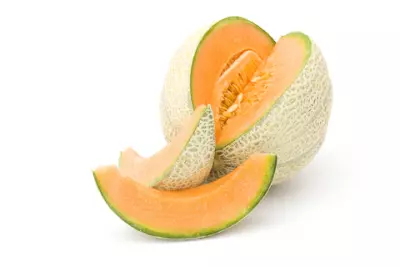
Cantaloupe has a Nutrivore Score of 457, making it a high nutrient-dense food! Plus, it is a low-carb and low-calorie-density food; the calorie count of cantaloupe is 54 calories per cup!
Per serving, cantaloupe is a best source (>50% daily value) of vitamin C; and an excellent source (20-50% daily value) of carotenoids, polyphenols, and vitamin A.
Ditch Diets. Embrace Nutrients. Start with These 5 Free Guides.
Sign up for the free weekly Nutrivore Newsletter and get 5 high-value downloads—delivered straight to your inbox—that make healthy eating simple and sustainable.

Cantaloupe Nutrition Facts
One serving of cantaloupe is standardized to 1 cup, diced or about 160 grams (5.6 ounces). A typical medium-sized cantaloupe (5″ diameter) weighs 552 grams, which is roughly equivalent to 3 1/2 servings of cantaloupe. A typical wedge from a medium-sized cantaloupe (1/8 of cantaloupe) weighs 69 grams, which means: one serving of cantaloupe is approximately equivalent to 2 1/2 wedges of a medium-sized cantaloupe.
Cantaloupe Nutrition Facts Per Serving
| Cantaloupe, raw | Nutrivore Score: 457 | Nutrient Density: High |
|---|---|---|
| Serving Size: 1 cup, diced (160 grams) | Protein: 1.3 grams | Net Carbohydrates: 11.6 grams |
| Calories: 54 | Total Fat: 0.3 grams | Dietary Fiber: 1.4 grams |
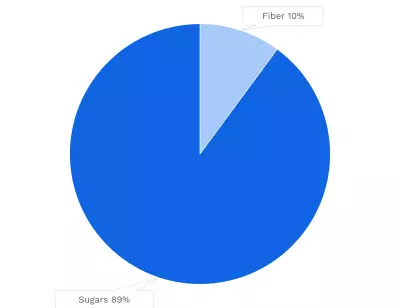


| VITAMINS | ||
|---|---|---|
| Vitamin A | 270.4 μg RAE | 30% DV |
| Vitamin B1 (Thiamin) | 65.6 μg | 5% DV |
| Vitamin B2 (Riboflavin) | 30.4 μg | 2% DV |
| Vitamin B3 (Niacin) | 1.2 mg | 7% DV |
| Vitamin B5 (Pantothenic Acid) | 0.2 mg | 3% DV |
| Vitamin B6 (Pyridoxine) | 115.2 μg | 7% DV |
| Vitamin B7 (Biotin) | 1.4 μg | 5% DV |
| Vitamin B9 (Folate) | 33.6 μg | 8% DV |
| Vitamin B12 (Cobalamin) | 0.0 μg | 0% DV |
| Vitamin C | 58.7 mg | 65% DV |
| Vitamin D (D2 + D3) | 0.0 μg | 0% DV |
| Vitamin E | 0.3 mg | 2% DV |
| Vitamin K | 4.0 μg | 3% DV |
| Choline | 12.2 mg | 2% DV |
| Myo-Inositol | ~ | ~ |
| CoQ10 | ~ | ~ |
| FUNCTIONAL FATS | ||
|---|---|---|
| MUFA | 0.0 g | 0% DV |
| ALA | 73.6 mg | 5% DV |
| EPA + DHA | 0.0 mg | 0% DV |
| CLA | ~ | ~ |
| Linoleic Acid | 0.1 g | 0% DV |
| MCT’s | 0.0 g | ~ |
| MINERALS | ||
|---|---|---|
| Calcium | 14.4 mg | 1% DV |
| Copper | 65.6 μg | 7% DV |
| Iodine | ~ | ~ |
| Iron | 0.3 mg | 2% DV |
| Magnesium | 19.2 mg | 5% DV |
| Manganese | 65.6 μg | 3% DV |
| Phosphorus | 24.0 mg | 2% DV |
| Potassium | 427.2 mg | 9% DV |
| Selenium | 0.6 μg | 1% DV |
| Sodium | 25.6 mg | 1% DV |
| Zinc | 0.3 mg | 3% DV |
| PHYTONUTRIENTS | ||
|---|---|---|
| Carotenoids | 3300.8 μg | ~ |
| Polyphenols | 198.4 mg | ~ |
| Phytosterols | 9.9 mg | ~ |
| Glucosinolates | ~ | ~ |
| Thiosulfinates | ~ | ~ |
| Betalains | ~ | ~ |
| AMINO ACIDS & PEPTIDES | ||
|---|---|---|
| Taurine | ~ | ~ |
| Ergothioneine | ~ | ~ |
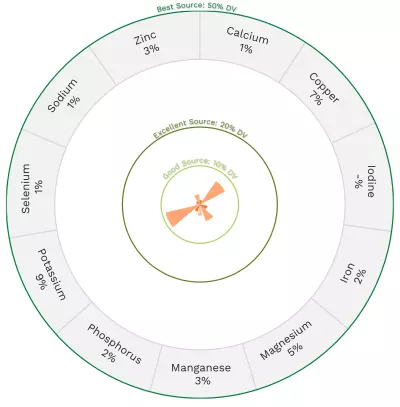

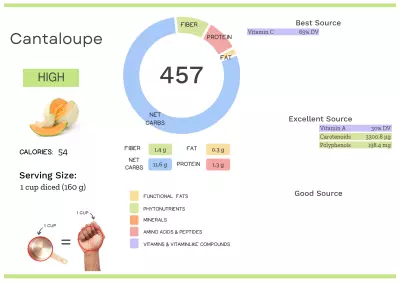
Did all the nutrition in cantaloupe blow your “rind”? Maybe your friends will be impressed too!
Health Benefits of Cantaloupe Nutrients
Let’s take a closer look at all of the best and excellent source of nutrients found in a 1-cup serving of cantaloupe and see how they benefit our health.
Cantaloupe Provides 65% DV Vitamin C
Cantaloupe is a best source of vitamin C, providing 65% of the daily value per 1-cup serving!

Vitamin C is a water-soluble vitamin that has powerful antioxidant properties (meaning it can help combat oxidative damage from free radicals and reactive oxygen species) and that serves as an enzyme cofactor (meaning it’s needed for enzymes to do their job, for example vitamin C is necessary for collagen synthesis, which is essential for bones, joints, teeth, blood vessels, skin and eyes) and playing important roles in immune system and skin health. Higher intakes of vitamin C are linked to reduced risk of heart disease, some forms of cancer, type 2 diabetes, cataracts, age-related macular degeneration, and gout. Vitamin C can also help regulate the stress response and reduce anxiety, and there’s preliminary evidence that it may also help prevent Alzheimer’s disease. Learn more about vitamin C here.
Cantaloupe Provides 3300.8 μg of Carotenoids
Cantaloupe is an excellent source of carotenoids, providing 3300.8 μg of carotenoids per 1-cup serving!
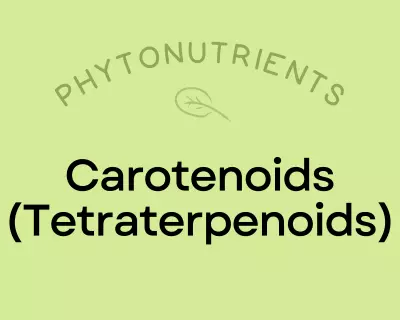
Carotenoids are a diverse group of phytonutrients that are responsible for giving fruits and vegetables vibrant red, orange, and yellow pigmentation. They were one of the earliest phytonutrients ever investigated by scientists (with research dating back to the 1800s!). Across studies, eating foods high in carotenoids appears to reduce the risk of head and neck cancers, supports vision health (particularly age-related eye diseases), may protect against metabolic syndrome and diabetes, and can reduce inflammation. Carotenoids have strong antioxidant properties, and help facilitate communication between cells by promoting the synthesis of connexin proteins, which create gap junctions in cell membranes that allow small molecules to be exchanged (which is part of how cells “talk” to each other!). Consuming carotenoids with fat significantly increases their absorption. Learn more about carotenoids here.
Cantaloupe Provides 30% DV Vitamin A
Cantaloupe is also an excellent source of vitamin A, providing 30% of the daily value per 1-cup serving!
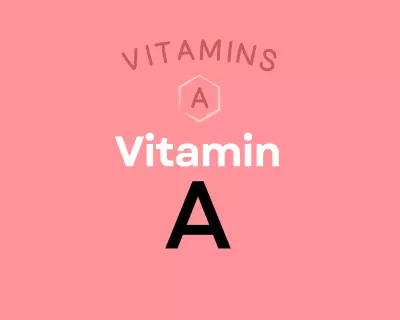
Vitamin A is actually a group of fat-soluble retinoids with vitamin A activity in the body. This nutrient is essential for a number of physiological functions—particularly vision, reproduction, thyroid health, immunity, and cellular communication. Getting enough vitamin A helps protect against some vision disorders (like night blindness and macular degeneration), supports a healthy menstrual cycle and sperm production, reduces infection risk, and allows for proper growth and development from the fetal years through childhood. Learn more about vitamin A here.
Cantaloupe Provides 198.4 mg of Polyphenols
Cantaloupe is a great source of polyphenols, providing 198.4 mg of polyphenols per 1-cup serving!
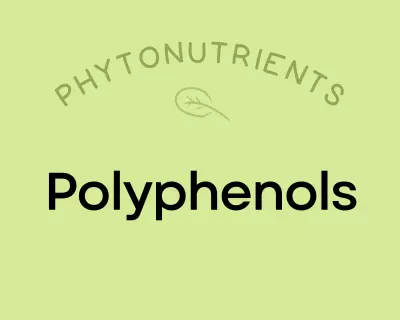
Polyphenols play a huge role in protecting against cancer, heart disease, diabetes, asthma, osteoporosis, neurodegenerative diseases, and other conditions associated with oxidative stress. In fact, a major reason foods like red wine and olive oil (as well as diets rich in both, such as the Mediterranean diet) show up as so beneficial may be due to their high polyphenol content! Along with chronic diseases, supplementing with polyphenols has been shown to protect against infections and reduce the signs of aging. Polyphenols exert their most potent effects by acting as antioxidants—preventing cellular damage by neutralizing hazardous oxygen radicals and improving cellular health as a result (which, in turn, benefits virtually every system in the body). As a result of their antioxidant properties, polyphenols also boost the immune system and protect against both chronic and acute diseases. In addition, polyphenols can help regulate enzyme function, stimulate cell receptors, modulate the functions of inflammatory cells (including T and B lymphocytes, macrophages, platelets, and natural killer cells), alter adhesion molecule expression, affect nerve cells and cardiac muscle cells, and exert antiviral effects. Learn more about polyphenols here.
Want to know the top 500 most nutrient-dense foods?

Top 500 Nutrivore Foods
The Top 500 Nutrivore Foods e-book is an amazing reference deck of the top 500 most nutrient-dense foods according to their Nutrivore Score. Think of it as the go-to resource for a super-nerd, to learn more and better understand which foods stand out, and why!
If you are looking for a quick-reference guide to help enhance your diet with nutrients, and dive into the details of your favorite foods, this book is your one-stop-shop!
Buy now for instant digital access.
How Much Cantaloupe Should We Eat Per Day?
Not only are melons tasty and refreshing, but they also supply a helpful mix of micronutrients and phytonutrients to support our overall health. I guess that means you could say these fruits are “one in a melon!” (Hyuck!)
Eating two or three servings of fruit per day is optimal from a health perspective. A 2017 systemic review and meta-analysis looked at how all-cause mortality was impacted by varying intakes of 12 different food groups: whole grains and cereals, refined grains and cereals, vegetables, fruits, nuts, legumes, eggs, dairy products, fish, red meat, processed meat, and sugar-sweetened beverages. This analysis revealed non-linear relationships between how much of a particular food group we eat and how it impacts our health. While the results revealed no upper limit to the benefits of vegetable intake, the sweet spot for fruit intake was 300 grams daily. Intakes of fruit over 400 grams per day were not as beneficial as 300 grams, but the good news is that even intakes of 600 grams of fruits per day was superior to no fruit at all! This sweet spot for fruit intake translates to 2 to 3 servings of fruit daily.
And a 2018 review similarly concluded that two to three servings of fruit daily was optimal for reducing risk of cardiovascular disease, type 2 diabetes, obesity, chronic obstructive pulmonary disease, chronic constipation, and inflammatory bowel disease.
Fruit makes a convenient snack, a healthy dessert, a whimsical addition to salads, and a sophisticated flavoring agent in the form of salsas, jams, and chutneys. A serving is standardized to 1 cup chopped for raw vegetables and fruits (typically translates to 1/2 cup to 2/3 cup once cooked). Learn more in Importance of Vegetables and Fruit
Components of cantaloupe extract have been shown to protect against diabetic nephropathy (kidney disease) in rodent models of type 2 diabetes, as well as reverse diet-induced changes in blood sugar, blood lipids, insulin, and thyroid hormones, while aqueous extract of cantaloupe was shown to have cytotoxic activity against human prostate cancer cells.
It’s always best to mix up the fruits and veggies you eat day to day (aiming for a wide variety of different vegetables and fruits throughout the week), and cantaloupe definitely has a place at the table.
Easily track your servings of Nutrivore Foundational Foods!

The Nutrivore Weekly Serving Matrix
The Nutrivore Weekly Serving Matrix digital resource is an easy-to-use and flexible weekly checklist designed to help you maximize nutrient-density and meet serving suggestions of Nutrivore foundational foods, all without having to weigh or measure your foods!
Includes a 22-page instructional guide and downloadable interactive guides.
Buy now for instant digital access.
cITATIONS
Expand to see all scientific references for this article.
Nystrom L, Schar A, Lampi AM. Steryl glycosides and acylated steryl glycosides in plant foods reflect unique sterol patterns. European Journal of Lipid Science and Technology. 2012. Vol 114(6):656-669. doi: https://doi.org/10.1002/ejlt.201200033.
Phenol-Explorer: Cantaloupe
USDA Food Central Database: Melons, cantaloupe, raw
Watanabe T, Kioka M, Fukushima A, Morimoto M, Sawamura H. Biotin content table of select foods and biotin intake in Japanese. Int J Anal Bio-Sci. 2014. Vol 2(4):109-125.


